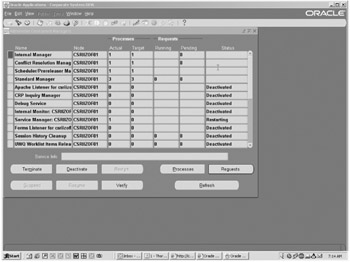Controlling Concurrent Managers
|
| < Day Day Up > |
|
Checking the Status of a Manager
Applications Interface Method
Through the Applications interface, you can check the status of Concurrent Managers by logging in with an ID that has sysadmin responsibility. Log into the sysadmin responsibility and navigate to the Concurrent Manager Administration Page. Figure 12.2 shows the navigation screen.

Figure 12.2: Concurrent Manager Administration Screen
On this screen, check to make sure that the nonzero numbers in the Target and Actual columns match. Target is the number of processes that should be running for each individual manager during the current work shift. The Actual column shows the number of processes that are actually currently running. If the number in the Target column is 0, that manager is not scheduled for this work shift. If the number in the Target column is not 0, but the number in the Actual column is 0, then you should have processes running for the given manager, but do not.
Further information can be gathered from this screen.
SQL Script Method
A less descriptive method to determine if the Concurrent Manager is running on the system is to find the afimchk.sql script located in your $FND_TOP/sql directory and run that script at a SQL prompt:
SQL>@$FND_TOP/sql/afimchk
Operating System Process Method
An operating Concurrent Manager creates a library process at the OS level on the Concurrent Manager host server. The ICM creates a process called FNDLIBR. If you run the following command, you can get an idea of what library processes you have running on your server. Table 12.7 will show you a sample of the output from that command:
ps -ef |grep LIBR
|
D:\visappl>ps -ef |grep LIBR 36 3080 3064 0 Jun 09 CONIN$ 0:00 cmd/c d:\visappl\fnd\11.5.0\bin\FNDLIBR.EXE FND CPMGR "FMDCPMBR sysmgr=APPS/apps@VIS sleep=20 pmon=60 qu esiz=1 diag=N logfile=d:\\viscomn/admin\\log/VIS\\ CM_VIS.log" 2>d:\viscomn/admin\log/VIS\CM_VIS.log 36 3100 3080 0 Jun 09 CONIN$ 0:07 d:\visappl\fnd\11.5.0\bin\FNDLIBR.EXE FND CPMGR "FMDCPMBR sysmgr=APPS/apps@VIS sleep=20 pmon=60 quesiz=1 diag=N logfile=d:\\viscomn\/admin\\log/VIS\\CM_VIS.log" 36 3048 3100 0 Jun 09 CONIN$ 0:04 d:\visappl \fnd\11.5.0\bin\FNDLIBR.exe FND Concurrent_Processor "MANAGE OLOGIN="APPS/94A491A100000000000000 00000000000000000000000000000000000000" QAPPL="FND" QUEUE="STANDARD" PMONMETH="LOCK" DECRYPT=Y TARGET="MY_SERVER" CP" |
Oracle Application Manager Method
Now, with the advent of the Oracle Applications Manager to the 11i Suite, you can, through a Java free site, check on the status of your Concurrent Managers, define new managers, start and stop managers, and edit properties of current Concurrent Managers.
The same Target and Actual columns are available and they provide the same information as is available through the Concurrent Manager Administration Page. You can drill out quickly and easily to requests for each manager, the status for each manager, and the running and pending request detail. Further, you can start and stop and activate and deactivate any of the defined managers.
Starting Individual Managers
You can activate or restart individual managers by changing their status in the Administer Managers form. Restarting a manager forces the Internal Manager to go out and reread that manager's definition. Activating a manager undoes a previous command to deactivate it and allows the Internal Manager to start it when its next scheduled work shift starts.
Deactivating Individual Managers
Deactivation can take two different paths. You can either choose to deactivate a manager and abort all requests that that manager is acting on or you can choose to allow it to finish its active requests before it shuts down. Terminated requests are marked for resubmission the next time that the manager is activated. If a manager is explicitly deactivated, it has to be explicitly activated and the Internal Manager has to be active at the time of reactivation.
Concurrent Programs are designed in such a way that regardless of the reason for termination, there will be no data loss.
|
| < Day Day Up > |
|
EAN: 2147483647
Pages: 122